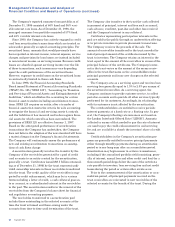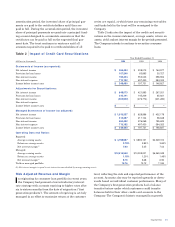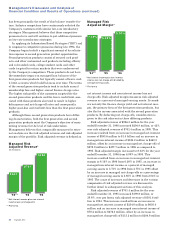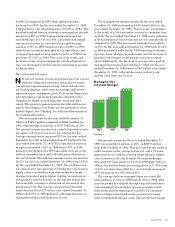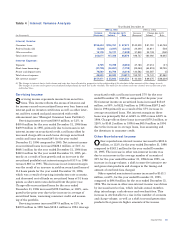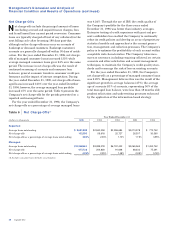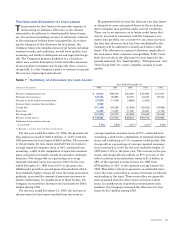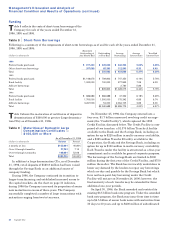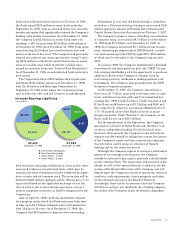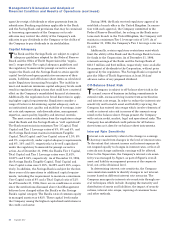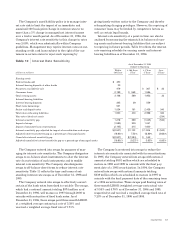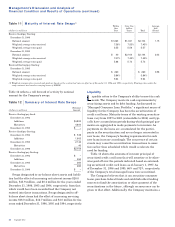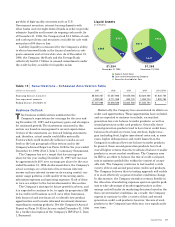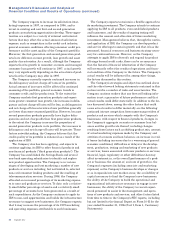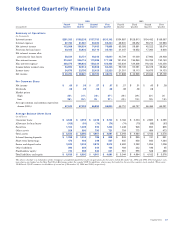Capital One 1996 Annual Report Download - page 31
Download and view the complete annual report
Please find page 31 of the 1996 Capital One annual report below. You can navigate through the pages in the report by either clicking on the pages listed below, or by using the keyword search tool below to find specific information within the annual report.
Capital One 29
Table 7 Summary of Allow ance for Loan Losses
Year Ended December 31
(dollars in thousands) 1996 1995 1994 1993 1992
Balance at beginning of year $ 72,000 $ 68,516 $ 63,516 $ 55,993 $ 31,541
Provision for loan losses 167,246 65,895 30,727 34,030 55,012
Transfer to loans held for securitization (27,887) (11,504) (4,869) (2,902)
Increase from consumer loan purchase 9,000
Charge-offs (115,159) (64,260) (31,948) (39,625) (44,666)
Recoveries 13,300 13,353 11,090 16,020 14,106
Net charge-offs(1) (101,859) (50,907) (20,858) (23,605) (30,560)
Balance at end of year $ 118,500 $ 72,000 $ 68,516 $ 63,516 $ 55,993
Allowance for loan losses to loans
at year-end(1) 2.73% 2.85% 3.07% 3.41% 4.29%
(1) Excludes consumer loans held for securitization.
For the year ended December 31, 1996, the provision for
loan losses increased to $167.2 million, or 154%, from the
1995 provision for loan losses of $65.9 million. The increase
in the provision for loan losses resulted from increases in
average reported consumer loans of 24%, continued loan
seasoning, a shift in the composition of reported consumer
loans and general economic trends in consumer credit per-
formance. Net charge-offs as a percentage of average
reported consumer loans increased to 3.63% for the year
ended December 31, 1996 from 2.03% in the prior year.
Additionally, growth in second generation products which
have modestly higher charge-off rates than first generation
products, increased the amount of provision necessary to
absorb credit losses. In consideration of these factors, the
Company increased the allowance for loan losses by $46.5
million during 1996.
For the year ended December 31, 1995, the increase in
the provision for loan losses resulted from increases in
average reported consumer loans of 37%, continued loan
seasoning, a shift in the composition of reported consumer
loans and a softening in U.S. consumer credit quality. Net
charge-offs as a percentage of average reported consumer
loans increased to 2.03% for the year ended December 31,
1995 from 1.13% in the prior year. The increase in the pro-
vision and charge-off rate reflects an 87% increase in the
seller’s interest in securitization trusts to $1.4 billion, or
48%, of the reported average balance for 1995 from
$700 million, or 33%, of the reported average balance for
1994. This seller’s interest represents an undivided inter-
est in the trust receivables in excess of investor certificates
outstanding in the trust. These receivables are generally
more seasoned than the other newer on-balance sheet
loans. In consideration of growth in second generation
products, the Company increased the allowance for loan
losses by $3.5 million during 1995.
Provision and Allow ance for Loan Losses
The provision for loan losses is the periodic expense of
maintaining an adequate allowance at the amount
estimated to be sufficient to absorb possible future losses,
net of recoveries (including recovery of collateral), inherent
in the existing on-balance sheet loan portfolio. In evaluat-
ing the adequacy of the allowance for loan losses, the
Company takes into consideration several factors including
economic trends and conditions, overall asset quality, loan
seasoning and trends in delinquencies and expected charge-
offs. The Company’s primary guideline is a calculation
which uses current delinquency levels and other measures
of asset quality to estimate net charge-offs. Once a loan is
charged off, it is the Company’s policy to continue to pursue
the recovery of principal and interest.
Management believes that the allowance for loan losses
is adequate to cover anticipated losses in the on-balance
sheet consumer loan portfolio under current conditions.
There can be no assurance as to future credit losses that
may be incurred in connection with the Company’s con-
sumer loan portfolio, nor can there be any assurance that
the loan loss allowance that has been established by the
Company will be sufficient to absorb such future credit
losses. The allowance is a general allowance applicable to
the on-balance sheet consumer loan portfolio. Table 7 sets
forth the activity in the allowance for loan losses for the
periods indicated. See “Asset Quality,” “Delinquencies” and
“Net Charge-Offs” for a more complete analysis of asset
quality.



